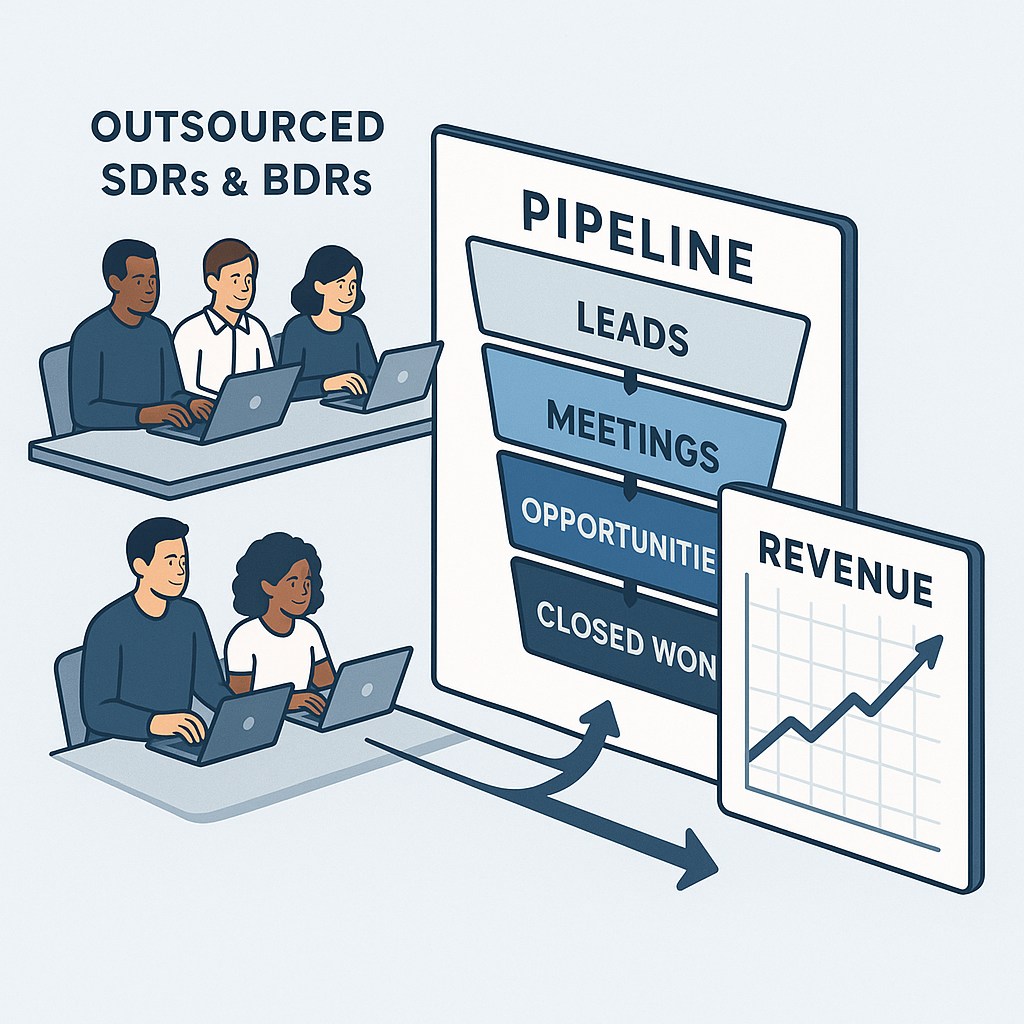BDR Lead Qualification: How to Turn MQLs into Sales-Ready Opportunities
If your BDRs treat every inbound lead the same, you're not just wasting time. You're wasting pipeline. The real question for Demand Gen Directors: ...
%20(23).png?width=302&height=302&name=_SD%20web%20assets%202025%20(500%20x%20500%20px)%20(23).png)
6 min read
Eric Smith
:
Sep 24, 2025 2:00:01 PM
Is your BDR team generating qualified sales leads, or just logging activity? For RevOps leaders, that distinction is everything. When metrics focus on volume over value, the pipeline gets noisy, forecasting becomes unreliable, and revenue suffers.
You need clarity. You need a lead qualification framework that filters signal from noise and ties directly to revenue outcomes.
According to 6sense’s State of the BDR 2025 report, teams with structured success metrics outperform their peers by 15% in quota attainment. The difference? Clear expectations, unified tooling, and qualification criteria that actually reflect buyer intent.
Are you measuring what matters—or just measuring what’s easy? This guide breaks down the essential BDR success metrics that align sales development with pipeline growth, so you can scale performance with precision.
Success in business development depends on more than just hitting activity quotas. It depends on your ability to measure what truly drives revenue: BDR lead qualification accuracy, pipeline contribution, and conversion efficiency.
BDR success metrics are the KPIs used to evaluate the effectiveness of sales development reps. These metrics form the foundation of a scalable sales lead qualification framework by measuring how well reps identify sales-ready leads, apply qualification criteria, and create pipeline velocity. Without them, you're flying blind.
BDRs are not just outbound machines. They're the first filter in your sales pipeline qualification process. Their responsibility is to assess buyer intent signals, apply a lead scoring framework, and generate conversion-ready leads that meet sales’ expectations. When qualification is weak or inconsistent, AEs waste time on poor-fit accounts, and deal cycles stretch.
RevOps needs to define the BDR role in lead qualification clearly: who they should target, how they score leads, and when a handoff is justified. For organizations leveraging external teams, a clearly defined SDR & BDR outsourcing strategy is essential to maintain qualification consistency and pipeline standards.
Metrics drive momentum. A robust B2B lead qualification strategy needs measurable success indicators tied directly to revenue goals. That includes tracking how many qualified meetings convert, how much pipeline is influenced by BDRs, and how long it takes to move prospects through the lead nurturing process.
Sustained BDR performance relies on a consistent, repeatable model that reduces subjectivity in qualification. By standardizing KPIs across your BDR team, you enable structured coaching, smarter territory planning, and more accurate forecasting. It also allows you to refine your lead scoring models and continuously improve lead qualification accuracy over time.
Tracking the right metrics is the backbone of a scalable BDR lead qualification process. When RevOps teams focus on outcomes tied to revenue, not just activities, they unlock cleaner forecasting, better coaching opportunities, and higher-performing sales development reps. Below are the core metrics that signal whether your BDR team is qualifying effectively and generating a pipeline that converts.
This is your leading indicator of a functional BDR funnel. A qualified meeting must meet your predefined qualification criteria, commonly based on frameworks like BANT, CHAMP, or MEDDIC. These meetings should represent high-intent prospects that match your lead scoring model.
Log meetings in your CRM, confirm AE acceptance, and monitor no-show rates. Audit weekly to maintain consistent benchmarks across teams. If your average is slipping, revisit your prospect qualification steps and messaging sequences.
This is where your lead nurturing process shows ROI. Track how many initial BDR touches convert into qualified sales opportunities. The formula is straightforward:
(Opportunities Created ÷ Outreach Attempts) × 100.
A high conversion rate signals effective targeting, relevant messaging, and a strong disqualification discipline. If the rate is low, investigate if reps are using the lead qualification checklist correctly or over-prioritizing vanity outreach.
Beyond meetings, this metric captures the financial value BDRs add. It measures the total dollar value of qualified sales opportunities sourced by BDRs. Attribute this directly in your CRM to ensure visibility into which leads contribute real pipeline momentum.
High-performing BDRs don’t just book meetings. They open deals with real revenue potential. Review this monthly to highlight reps who consistently generate conversion-ready leads with high intent. It also helps flag gaps in your B2B lead qualification strategy if value trends down while volume stays flat.
This measures how long it takes for a BDR-sourced lead to close, starting from the first touchpoint. It reflects the accuracy of your BDR lead qualification process. Shorter cycles usually mean better alignment with ICPs, cleaner qualification, and smoother AE handoffs.
If deal cycles are long or inconsistent, re-evaluate your qualification vs disqualification criteria. You might be pushing leads too early or failing to identify key buyer intent signals during outreach.
Call volume, emails sent, and LinkedIn touches are easy to track—but without context, they are just noise. Outcome metrics like booked meetings, pipeline value, and opportunity conversion offer a clearer picture of BDR effectiveness.
Map outreach efforts to outcomes that move deals forward. If a rep makes 500 calls but books only 3 meetings, something is broken in either targeting or messaging. Sales teams benefit from tools that connect activity tracking with performance analytics, especially those that highlight what behaviors consistently lead to qualified sales opportunities. When systems remain siloed, it becomes harder to diagnose inefficiencies or replicate what’s working.
Reliable measurement requires more than dashboards. RevOps teams need structured systems that tie activity to outcomes, ensure consistency across reps, and eliminate guesswork from reporting. Here are three proven methods to measure BDR performance at scale:
Centralize Metrics in Your CRM
Centralize all performance data in a single source of truth, typically your CRM. Build real-time dashboards that surface key KPIs: meetings booked, conversion rates, pipeline value, and deal velocity. Avoid spreadsheets or disconnected tools that lead to version control issues and reporting delays. When systems are centralized, it’s easier to monitor trends, coach effectively, and scale insights across teams.
Define SMART Goals at the BDR Level
Goals should be Specific, Measurable, Achievable, Relevant, and Time-bound. For example: “Each BDR books 25 qualified meetings per month tied to at least $50K in forecasted pipeline.” Align individual goals with sales targets and review them quarterly. Without this alignment, reps may optimize for the wrong activities—like booking volume instead of lead quality.
Automate Tracking and Performance Reporting
Manual reporting slows decision-making and invites data integrity issues. Use workflow automation to capture outreach activity, attribute pipeline influence, and track lead progression through the funnel. Automation supports A/B testing and provides real-time insights into which tactics generate a qualified pipeline. For teams scaling fast or lacking in-house bandwidth, partnering with SmithDigital for Outsourced BDR Services can streamline execution and deliver pipeline-ready results from day one.
Even with advanced tooling, RevOps teams often encounter blind spots that distort performance insights. Addressing these friction points is key to building an accurate, accountable BDR performance model.
Chasing Vanity Metrics Over Revenue Impact
High activity doesn’t always mean high performance. Tracking email volume, call counts, or social touches in isolation creates a false sense of progress. What matters is how consistently those activities lead to qualified meetings and pipeline generation. If reps are logging hundreds of touches but not influencing deals, it’s time to reevaluate your lead qualification checklist and targeting strategy.
Fragmented Data Across Marketing and Sales
When marketing and BDR teams operate on separate systems or definitions, performance visibility breaks down. Misaligned lead scoring frameworks or disconnected CRMs often result in lost leads and inaccurate attribution. Centralizing data and using shared qualification criteria ensures that handoffs are clean and reporting reflects true funnel performance.
Poor Alignment Between BDRs and AEs
A weak handoff process leads to dropped leads, miscommunication, and pipeline leakage. BDRs should sync regularly with AEs to define qualification vs disqualification criteria, review recent handoffs, and align on what constitutes a sales-ready lead. Outsourced BDR programs require even tighter alignment to avoid dropped handoffs. See how leading teams approach this in our SDR & BDR outsourcing strategy guide.
Collecting data is only the first step. The real leverage comes from using performance metrics to sharpen execution, align incentives, and continuously improve results. Below are key practices RevOps teams should implement to turn metrics into momentum.
Metrics should fuel conversations, not just dashboards. Conduct biweekly 1:1s with each BDR to review trends in KPIs—meeting conversion rates, pipeline influence, and lead quality. Don’t just focus on snapshots. Look for patterns: Is a rep’s conversion rate dipping over time? Are high activity levels producing weak opportunities?
Use conversation intelligence tools, if available, to analyze call recordings and pinpoint gaps in discovery, objection handling, or qualification. Frame coaching sessions around buyer intent signals and lead scoring accuracy, not just speed to meeting.
Compensation drives behavior. If you reward volume alone, don’t be surprised when reps book meetings that don’t convert. Structure incentives around revenue-impacting outcomes: meetings that advance to qualified opportunities, pipeline value sourced, and lead scoring alignment.
Consider layered SPIFFs that reward high conversion rates, faster handoffs, or improvement in lead quality over time. Tie base performance metrics directly to your sales pipeline qualification model to keep incentives aligned with business goals.
BDR strategies are never one-size-fits-all. Use A/B testing to refine subject lines, CTAs, messaging sequences, and outreach channels. Analyze performance by persona, industry, and segment. What works for mid-market might not land with enterprise.
Build a feedback loop where top-performing reps share insights, sequences are regularly refreshed, and underperforming approaches are sunset. Optimization should be data-driven, not anecdotal. Your lead qualification process is only as strong as your last round of testing.
Driving pipeline growth isn’t about tracking every metric—it’s about tracking the right ones. When RevOps teams prioritize qualified outcomes over raw activity, they turn their BDR program into a consistent revenue engine.
Structured measurement fuels better coaching, clearer forecasting, and higher conversion rates. With a defined qualification process and metrics that reflect true buyer intent, BDRs become a competitive advantage rather than a cost center.
Ready to move beyond guesswork? Get the KPI dashboard set up with SmithDigital and turn qualified metrics into qualified revenue.

If your BDRs treat every inbound lead the same, you're not just wasting time. You're wasting pipeline. The real question for Demand Gen Directors: ...
What’s the most effective way for a B2B company to attract high-quality leads and fuel long-term growth?

Building a consistent pipeline has never been more complex. Marketing and sales leaders are under pressure to fill funnels, drive revenue, and...